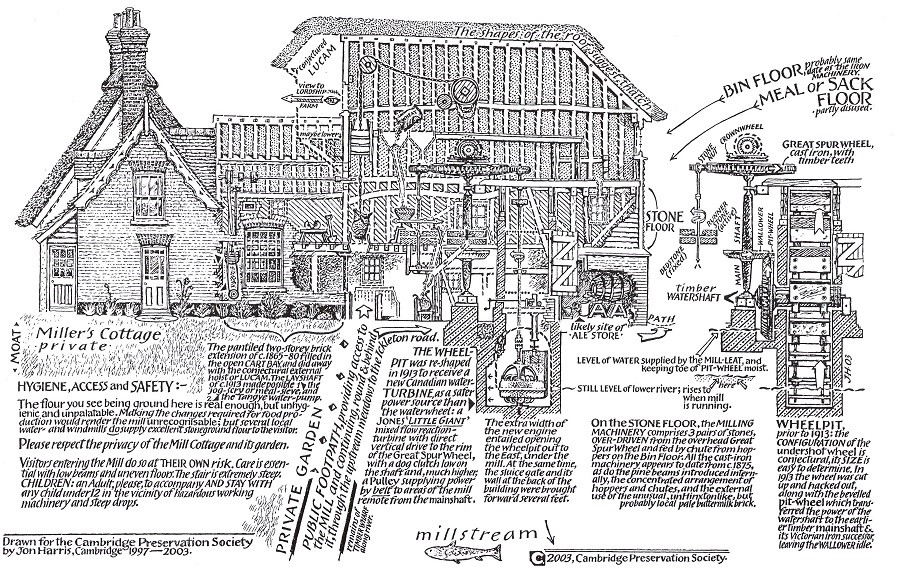About Hinxton Watermill
Hinxton Watermill is owned and cared for by local charity Cambridge Past, Present & Future, who saved it from demolition by purchasing and restoring the mill in the 1980s. The information below is reproduced with the kind permission of Cambridge Past Present & Future, additional information can be found on their website https://www.cambridgeppf.org/Pages/Category/hinxton-watermill
The corn mill on the River Cam at Hinxton is built on a very old site which is probably the one mentioned in the Domesday Survey in 1085 as being “worth 8 shillings”. The present building was constructed in the 17th century, whilst the adjoining cottage was built in the 18th century; an inscribed date of 1766 was found during repair work in the 1980s.
In the mid 19th century, the mill was extended in size by building towards the cottage and its front elevation was refaced with brick. It is thought that the front part of the cottage may have dated from about 1600 but this had to be largely rebuilt, although retaining the Victorian brick front.
The mill was originally powered by a breast shot waterwheel. It was replaced in 1913 by a Jones ‘Little Giant’ water turbine.

On the stone floor the mill gearing consists of a great spur wheel and three stone nuts, which are all in good order. The three pairs of millstones are driven from above (overdrift) by the great spur wheel, which is not a common practice in watermills but fairly common in windmills.
The mill contains many fascinating items of equipment, all essential to the millers’ activities and the numerous drives, shafts, belts and pulleys have been re-assembled. One particularly interesting item is the Tangye water pump on the ground floor, which pumped river water to tanks in the barn at next door Lordship Farm.
Restoration of Hinxton Watermill
The mill business, which ground grain for local farms, ceased to operate in 1955 and the mill was neglected from that date. The cottage, although occupied, was almost derelict with no mains water supply and the roof leaking in a dozen places.
In 1984 the local authority was about to put a closing order on the cottage, but Cambridge Past Present & Future stepped in to purchase and restore the property.
The aim of the restoration was to make the building structurally sound and bring the mill machinery into working order without losing the historic atmosphere of the building and its location. The unsightly corrugated iron roof was replaced with old clay peg-tiles and strengthened by inserting new rafters. Structural repairs were kept to a minimum and limewash was used to blend new surfaces with old.
The mill machinery was very complete and in good condition but the water turbine had seized up due to disuse. It was dismantled and cleaned out by sandblasting. The hardwood (lignum vitae) bearings were found to be in perfect condition.
The whole of the restoration of the mill and the cottage was funded by Cambridge Past Present & Future supported by grants from South Cambridgeshire District Council. The local community was very supportive and continues to be so to this day. The restoration work was carried out by RH Partnership Architects and won an award.
All historic buildings need ongoing care and maintenance and we are very grateful to the volunteers that care for the mill. We carried out further maintenance and restoration work in 2010 and 2015.The whole of the restoration of the mill and the cottage was funded by Cambridge Past Present & Future supported by grants from South Cambridgeshire District Council. The local community was very supportive and continues to be so to this day. The restoration work was carried out by RH Partnership Architects and won an award.
All historic buildings need ongoing care and maintenance and we are very grateful to the volunteers that care for the mill. We carried out further maintenance and restoration work in 2010 and 2015.
All historic buildings need the support of their local community and visitors. It is a challenge to raise sufficient funds in order to maintain this historic mill in working order. If you are able to make a donation or volunteer your time we would be very grateful. You can do this on the website of Cambridge Past, Present & Future https://www.cambridgeppf.org/help-hinxton-watermill